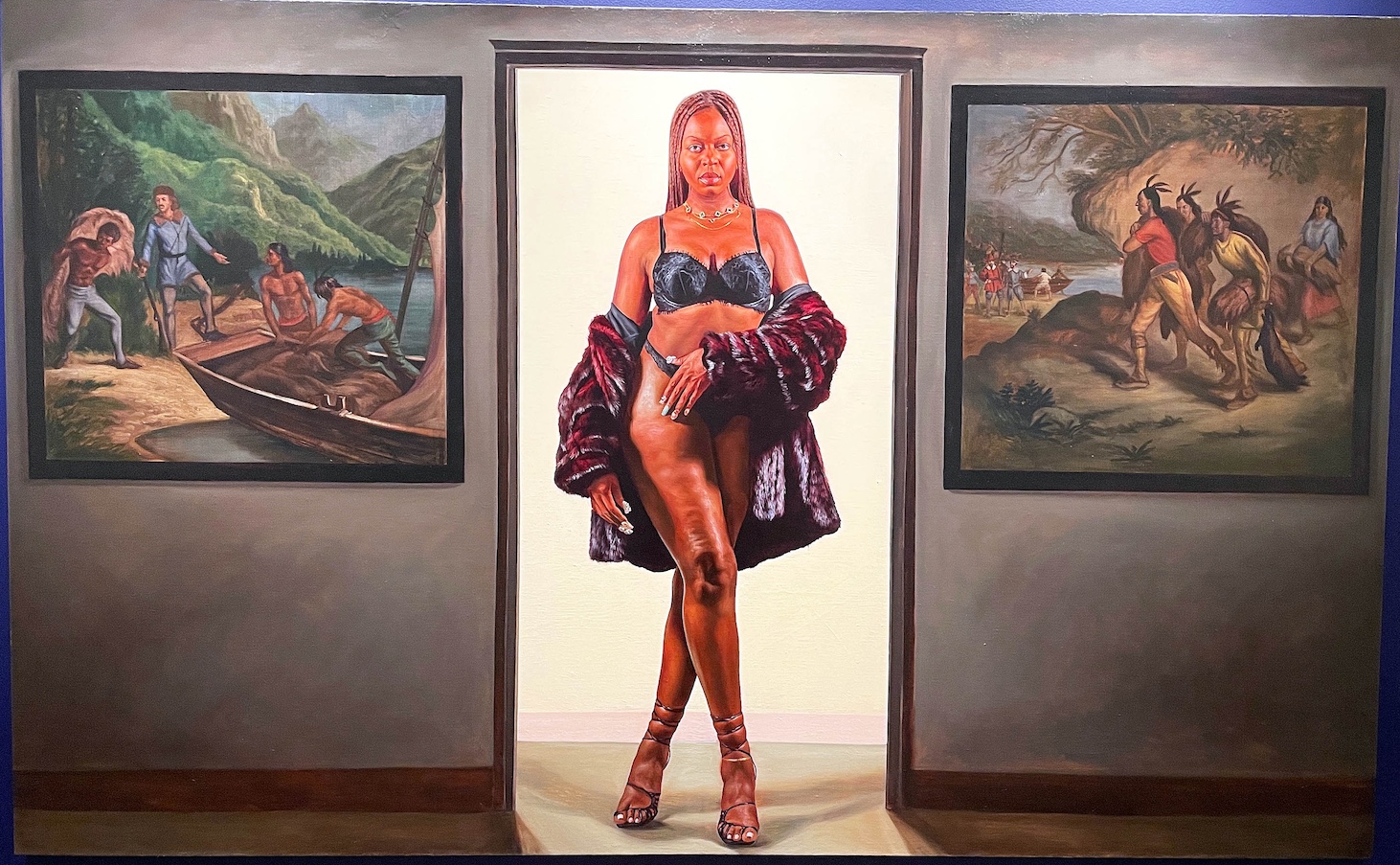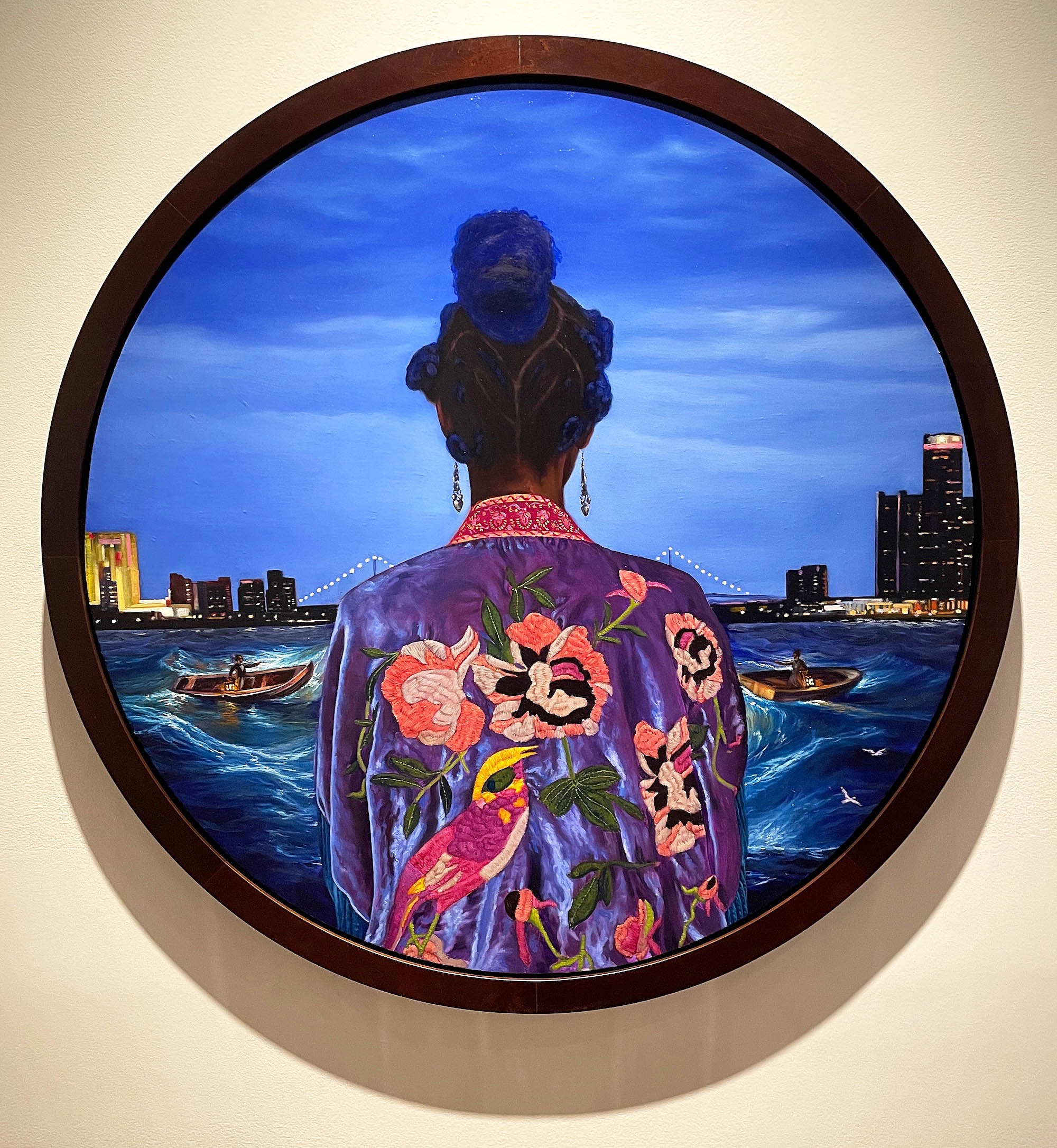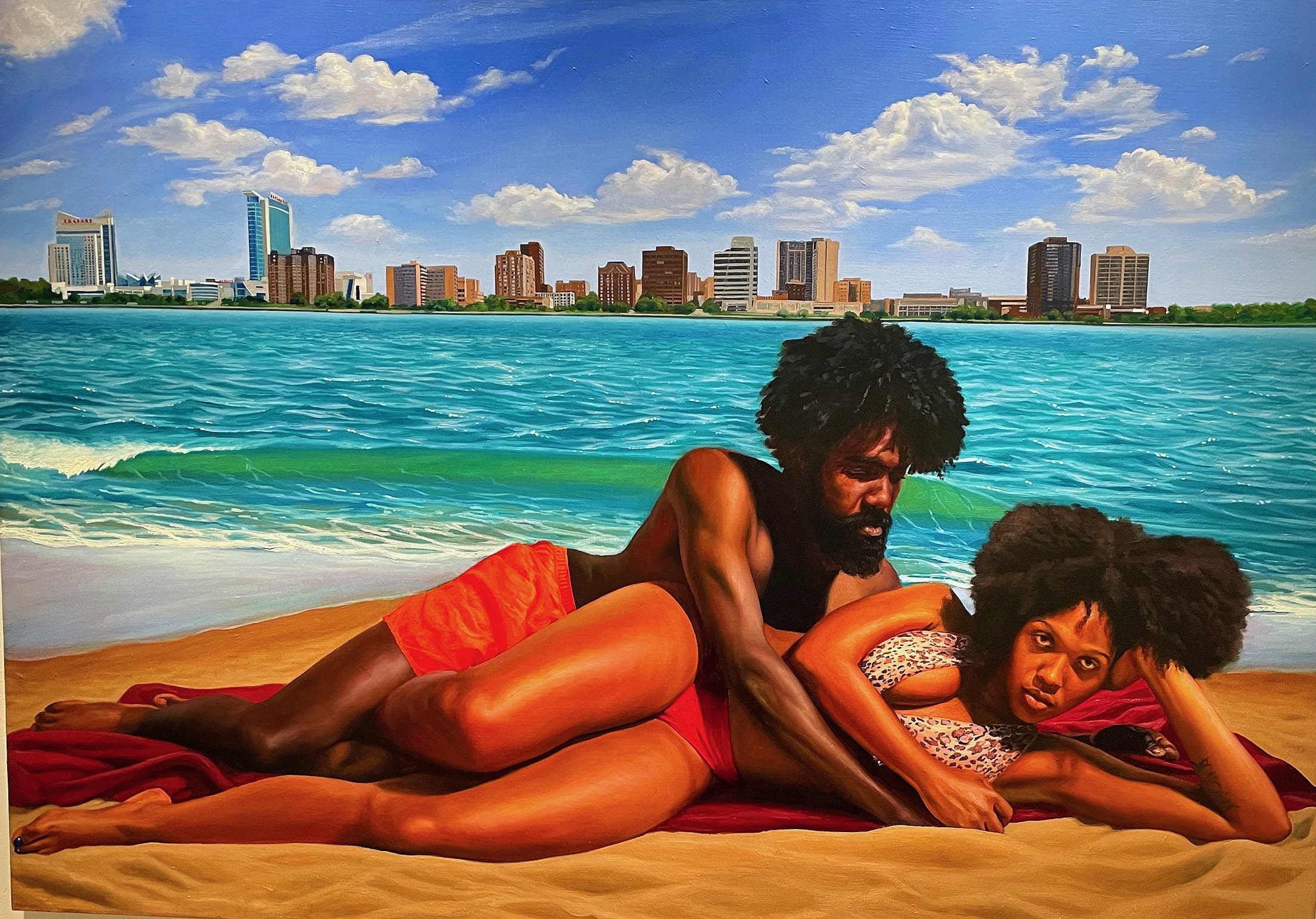The Flint Institute of Arts Presents Revolutionary Times by Detroit Artist Mario Moore
There’s a black-and-white video clip on YouTube of an early TV quiz show where a panel of celebrities tries to guess the identity of a mystery guest. In the clip, the guest is a frail-looking old man who turns out to be the last living witness to the shooting of Abraham Lincoln. The show aired in 1956. My father was born in 1947; he just turned 77, and his life overlaps that of someone who saw the Lincoln assassination. I remember being struck by that thought when I first saw the video, by the idea that the days of chattel slavery and civil war, which can seem like the stuff of textbooks, ancient history (and which some would like us to conveniently regard as such), were actually as close as the span of just two lifetimes. I thought of that video again as I looked at Mario Moore’s current exhibition at the Flint Institute of Arts, Revolutionary Times (running now through April 14), in which the painter repeatedly collapses the distance between the past and the present.

Michael Moore, Installation image, Revolutionary Times, FIA
It’s been quite a year so far for Mario Moore. In addition to the Flint show, the Cranbrook Art Museum is currently featuring a show Moore co-curated called Skilled Labor: Black Realism in Detroit, in which Moore joins several other local painters who work in a range of realist approaches (on view through March 3). Moore’s art is both highly skilled and labor intensive. He works at a level of realism that must be a bit like playing trumpet or violin, where the promise of perfection makes every flub the more obvious. Moore, however, rarely misses a note. While his backgrounds are more loosely painted to suggest depth, his subjects are meticulously rendered, and yet they aren’t fossilized by overly-fussy techniques. They breathe, and radiate warmth even when their demeanors are cool, which is often. When they meet the viewer’s gaze, there’s life in their eyes.

Mario Moore, The Drums Roll On,
Revolutionary Times comprises three bodies of work: one relates to the Civil War, particularly the Black troops who were armed to fight for the Union; another references the Underground Railroad and Detroit’s unique part in its history; and the third, a room of mostly portraits, comments on the fur trade in Detroit while honoring members of Moore’s family and circle of friends. Throughout the show, Moore juxtaposes images of “then and now,” sometimes placing 19th-century figures in modern landscapes, casting friends in the roles of historical personages, or inserting himself into portraits of family members. Each work dissolves the barriers between the historical and the contemporary. At the start of the exhibition, the viewer is greeted by The Drum Rolls On, an image of a barefoot Black child, eyes forward and resolute, the sticks in his hands poised to strike up a march on the snare drum slung around his neck. Around him, the landscape is in flames, yet he is unharmed and unperturbed. He’s an allegorical figure, though not a timeless one; the shiny calculator watch on his wrist tells us that the time is now.

Mario Moore, Espansion
The next image the visitor encounters is a lithograph featuring the first of a number of artists Moore name-checks throughout the exhibit: David Bowser, the designer of several regimental flags carried by Black troops during the Civil War (a Moore recreation of one of Bowser’s flags hangs elsewhere in the gallery). Across the room is another artist, Moore’s contemporary Mark Thomas Gibson. He’s depicted lounging in front of a Moore-ified version of his large drawing of the battle of Antietam, a fight in which Black troops played a crucial role and which precipitated Lincoln’s signing of the Emancipation Proclamation. In the battle scene, a Union soldier lies dead in one corner, his head blown off with such force that his hat still hovers above the stump of his neck. Gibson’s casual pose, sitting back in a chair with his feet up, mimics that of the collapsed soldier, suggesting that the soldier’s sacrifice then made Gibson’s freedom today possible. On another wall are several portraits based on Civil War-era photographs, now in full color and with the original subjects replaced by friends of Moore’s, all brandishing period swords and firearms. A spoken word recording about the arming of Black troops, Free State, plays in the first gallery as well, though without a chair or headphones it’s hard to give the 25-minute recording the attention it deserves.

Entering the second part of the exhibition, the visitor meets two bathing suit-clad figures, a man and woman, reclining on the shore of the Detroit River. They represent Lucia and Thornton Blackburn, an enslaved couple who fled Kentucky for Canada along the storied Underground Railroad. They eventually escaped to Windsor, depicted here by the apartment blocks and casinos of the city’s modern skyline, just as the Blackburns are portrayed by two friends of Moore’s, closing the gap between the two time periods. The Underground codename for Windsor was “Canaan”; Detroit was called “Midnight.” Between them runs the river, a fluid frontier that appears in the backgrounds of a number of the pictures in this gallery, most dramatically in Troubled Waters: Henry Bibb And/Or Mary Ann Shadd. In the painting, the titular abolitionists bob in precariously small boats on the rough waters of the strait, reaching out to one another yet separated by their differing views on tactics (Bibb welcomed white allies, and Shadd felt Black people could free themselves without them). In the foreground between the two boats, her back turned to the viewer to reveal her elaborately embroidered robe, a Black woman looks on as if contemplating the dispute, inviting us to do the same. Moore’s handling of water is excellent, especially the range of color he brings to the river, from industrial grays to translucent greens to deep blues. Also in this gallery are three large-scale portraits of anti-slavery figures with Michigan connections: William Lambert, George deBaptiste, and Sojourner Truth. Each is drawn in silverpoint, evoking daguerreotype photographs, and each is embellished by gold threads — provided by Moore’s mother, the artist and educator Sabrina Nelson — that chart routes along the Underground Railroad, adding a thoughtful graphic element to the portraits.

Mario Moore, The Drums Roll On
Detroit was founded 320-plus years ago as an outpost for the French fur trade, an industry that relied on the labor of enslaved Black people in order to thrive. The third gallery in the Flint exhibition depicts Moore’s friends and family dressed in fur, flipping the historical dynamic as well as celebrating a fashion statement that Moore has noticed is particular to Detroiters. His painting Expansion is a full-length portrait of local entrepreneur Cyndia Robinson, who stands framed in a doorway wearing black lingerie, as well as a fur jacket that once belonged to her mother. On either side of Robinson are historical paintings, like those still found in some libraries or schools, depicting the fur trade: white men with muskets receive furs delivered by Native American trappers, while an enslaved Black man shoulders a bundle of hides. On the opposite wall is the closest thing to an abstract image in the show, Moore’s striking bird’s-eye view portrait of Sheefy McFly, in which the rapper/artist/DJ, clad in an all-pink outfit and a brown fur coat, reclines in a small wooden boat. The vessel’s arrowhead shape, like a “you are here” pointer on a map, is sharpened by the field of dark cobalt water on which it floats. (If this painting hasn’t been used as an album cover yet, it’s something to consider!)

Michael Moore, Installation, Troubled
Bookending the exhibition is a stunning group portrait of five women: Moore’s wife, Danielle Eliska, his sister, mother, and his two grandmothers, arranged in a pyramid-shaped composition with Eliska’s profile at its peak. The women exude supreme strength and confidence. Arrayed around a table in a snowy forest environment, they look anything but cold; in fact, they glow with a warm, golden light in defiance of their icy surroundings. Moore’s love and admiration for these women he calls Pillars of the Frontier in the painting’s title is palpable. His mother, Sabrina Nelson, holds a pencil poised over her open sketchbook, recalling the poised drumsticks held by the child at the show’s beginning. She locks eyes with the viewer — really with her son, the painter painting her, as if to create his portrait in return, keeping the dialogue between generations alive.
The Flint Institute of Arts Presents Revolutionary Times by Mario Moore
